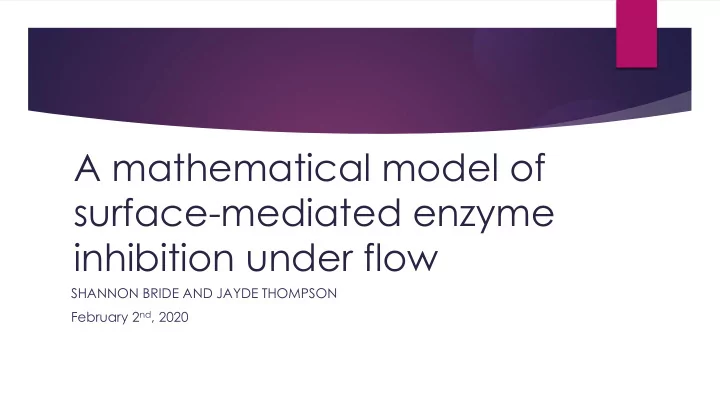

A mathematical model of surface-mediated enzyme inhibition under flow SHANNON BRIDE AND JAYDE THOMPSON February 2 nd , 2020
Blood coagulation is a complex system System of chemical reactions required to form a clot, which prevents bleeding Goal is to prevent bleeding but not over clot System in balance
System in balance Procoagulant components enzymes, platelets Anticoagulant components inhibitors What is flow? Procoagulant or anticoagulant?
One inhibitor under flow: TFPI TFPI is an inhibitor of the initiation of clotting Most studies done under static conditions Math model of small injury under flow indicated TFPI is not effective What is the role of TFPI under flow?
The initiation of coagulation: Step 1 Injury exposes TF to the blood • VIIa Clotting factor VIIa binds to TF • TF TF TF TF:VIIa TF:VIIa TF:VIIa Key: TF: Tissue Factor, VIIa: Activated factor VIIa
The initiation of coagulation: Step 2 Clotting factor X binds TF:VIIa • TF:VIIa activates factor X • Activated factor Xa is a • necessary enzyme for clotting Xa X X TF:VIIa TF:VIIa X:TF:VIIa TF:VIIa TF:VIIa Key: X: inactive factor X, Xa: active factor X
The inhibition of initiation: TFPI and Xa TFPI Xa TFPI Xa:TFPI Xa TFPI TFPI TF:VIIa TF:VIIa TF:VIIa TF:VIIa TF:VIIa TF:VIIa TF:VIIa TF:VIIa TFPI can directly inhibit Xa by binding in the bloodstream • This reaction is reversible • Key: Xa: active factor X, TFPI: Tissue Factor Pathway Inhibitor
The inhibition of initiation: Xa:TFPI and TF:VIIa TFPI TFPI X Xa:TFPI Xa TFPI TF:VIIa TF:VIIa TF:VIIa TF:VIIa TF:VIIa TF:VIIa TF:VIIa:Xa:TFPI The complex Xa:TFPI can rebind TF:VIIa and prevent further production of Xa • This is negative feedback • Key: X: inactive factor X, Xa: active factor X, TFPI: Tissue Factor Pathway Inhibitor
Does TFPI effectiveness depend on injury size? TFPI X Xa:TFPI X Xa TF:VIIa TF:VIIa TF:VIIa TF:VIIa TF:VIIa TF:VIIa TF:VIIa TF:VIIa TF:VIIa:Xa:TFPI This is negative feedback takes time and space to occur • This could impact the effectiveness of TFPI •
Advection Diffusion Reaction Model X, Xa, TFPI, and Xa:TFPI are species within the fluid modeled with ADR TF:VIIa, X:TF:VIIa, and TF:VIIa:Xa:TFPI are species bound to the wall Fluid and wall bound species interact through binding reactions via boundary conditions
Examples of PDEs
Testing TFPI effectiveness We will use the Advection-Diffusion-Reaction model while varying Initial condition of TFPI Patch lengths of exposed TF:VIIa Flow rate We will monitor production of Xa by monitoring X:TF:VIIa
Initial condition of TFPI
Patch Length of Exposed TF:VIIa
Flow Rates
Conclusion and Future Work TFPI effectiveness is dependent on: Initial condition of TFPI Patch length of TF:VIIa Flow rate Continuing the investigation: Add reactions to model
Acknowledgements Dr. Karin Leiderman for leading the project Dr. Nicholas Danes for mentoring along the way Colorado School of Mines Applied Mathematics Department
Questions?
Recommend
More recommend